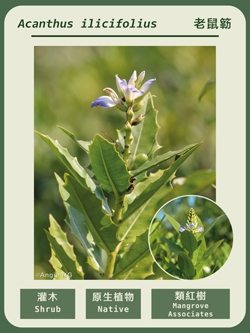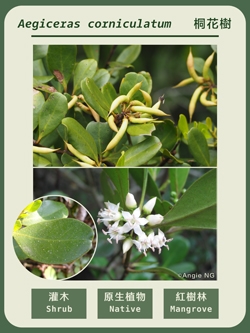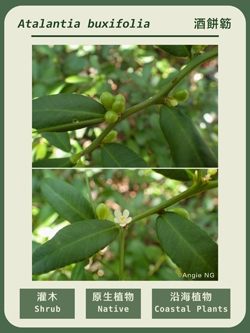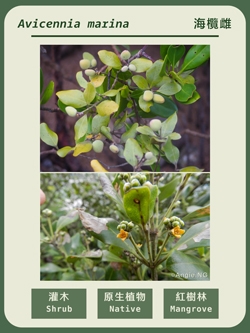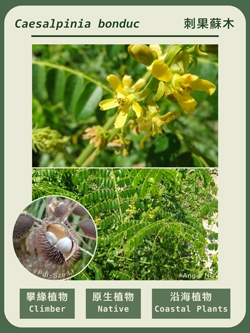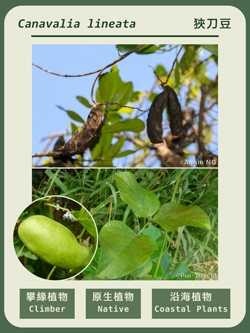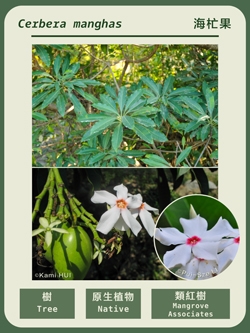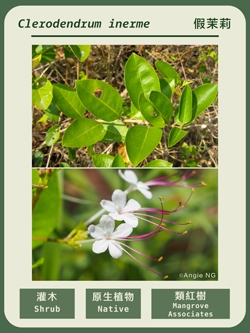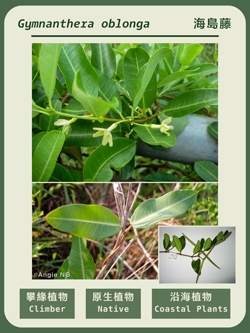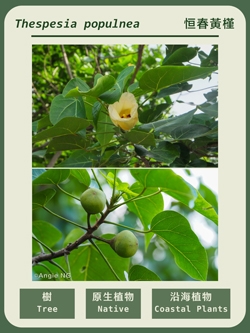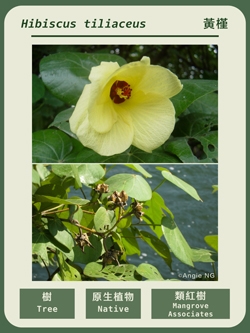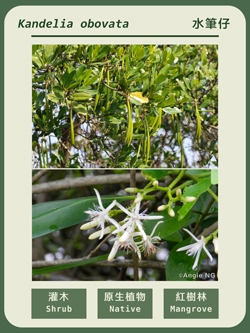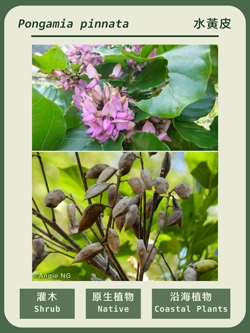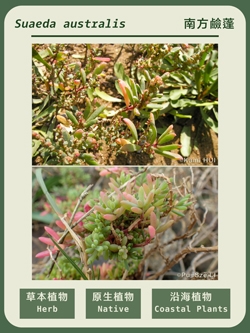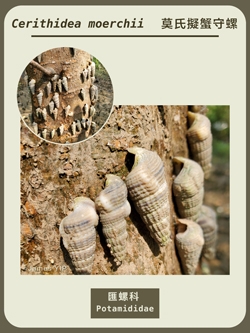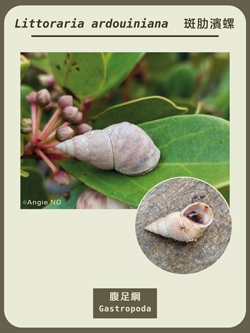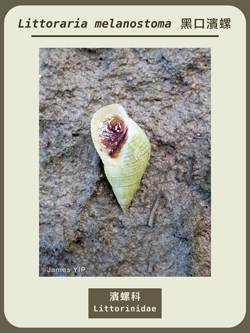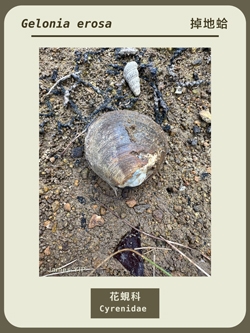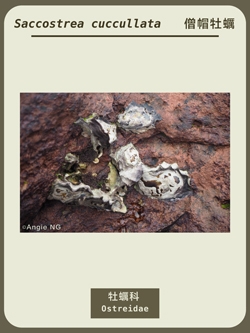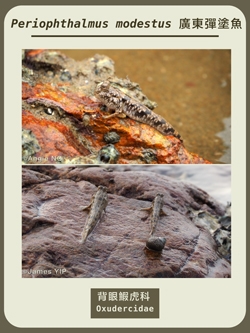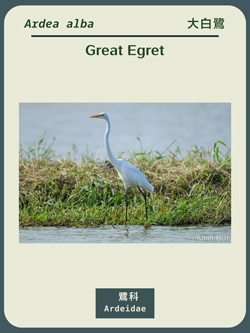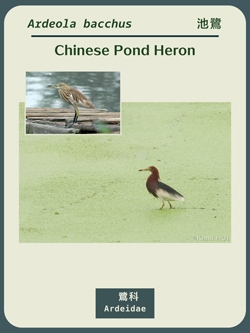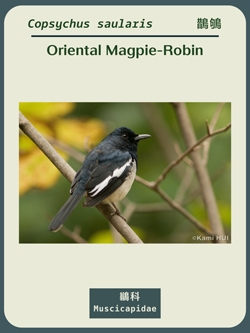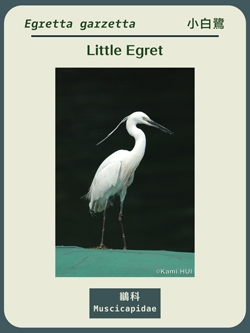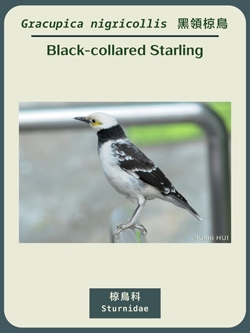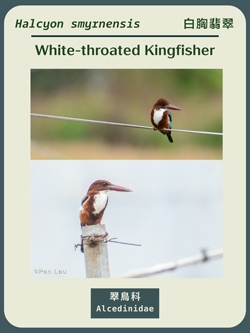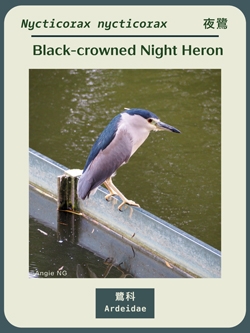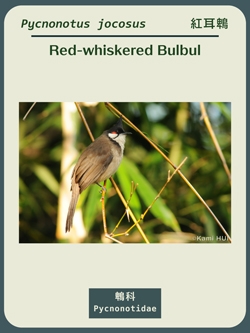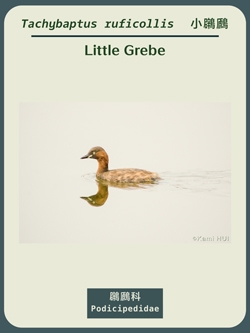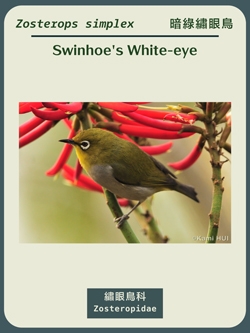Wetland Conservation > Characterizing mangrove functions in Tai O – an integrated approach from environmental and cultural perspectives > Fauna and Flora of Mangroves
The wetland habitat of mangroves nurtures high biodiversity of flora and fauna, including birds, crustaceans and other coastal organisms. The mangrove provides them with habitat used for foraging, living and breeding. Mangroves are environmentally characterized by high humidity, high salinity and strong wind, etc. Only plants with special features could adapt to such a stressful coastal environment, and mangrove trees are the representatives. Apart from mangroves, other plants could also adapt to wetland habitats and grow healthily.
Let’s learn more about the biodiversity of mangroves at Tai O.

| Scientific name | Description |
|
Acanthus ilicifolius
|
Acanthus ilicifolius (Spiny Bears Breech) is classified as an mangrove associate, mostly occurs in the upper tidal zone and occasionally grows in the mid-tidal zone. It fruits during summer (April–July). The oblong fruits have a long tail (style) and look like a mouse. The leaf margin is sometimes with few large spines, occasionally entire. |
|
Acrostichum aureum
|
Acrostichum aureum (Mangrove Fern) is classified as true mangrove. However, they are not trees but ferns. They are common in tropical coastal areas, in particular the back of mangrove. |
|
Aegiceras corniculatum
|
Aegiceras corniculatum (Goat’s Horn Mangrove) has a thick waxy layer covering on leaves which helps reduce water loss. And the plant has salt glands on the leaf epidermis that help excrete excess salt. This is why the excreted salt crystals can always be found on the leaf surface. |
|
Atalantia buxifolia
|
Atalantia buxifolia (Box-leaved Atalantia) are woody shrubs of the Rutaceae family. They are citrus-scented. Their stems are usually spiny. The spines can be as long as 4 cm. |
|
Avicennia marina
|
Avicennia marina (Black Mangrove) usually grows in the coastal area and salt marsh. It usually occurs in the front part of mangrove (i.e. the seaside). The salt glands on the leaf epidermis help excrete excess salt. Another feature is aerial roots known as pneumatophores, which grow above the ground for aeration. |
|
Caesalpinia bonduc
|
Caesalpinia bonduc (Gray Nickers) is a leguminous plant. It is a spiny vine with all parts yellow pubescent. Their leaves and mature fruits are used for traditional Chinese medicine. |
|
Canavalia lineata
|
Canavalia lineata (Narrow Sword Bean) is a leguminous plant that usually grows in beaches and river banks. Leaves are pinnately 3-foliolate. Leaflets with short petiolule. |
|
Cerbera manghas
|
Cerbera manghas, also named as Sea Mango (Cerbera), is classified as mangrove associate. Their fruits look like the mango that we consume. White latex will be produced whereas wounded. The whole plant is toxic, especially the seeds. Do not try to taste them. |
|
Clerodendrum inerme
|
Clerodendrum inerme is classified as mangrove associate. Branchlets tetragonal, pubescent. Their roots, stems and leaves are bitter and slightly toxic; even though they are used in traditional Chinese medicine to treat rheumatoid arthritis and other symptoms. |
|
Gymnanthera oblonga
|
Gymnanthera oblonga (Oblong Gymnanthera) is a climber commonly found in coastal areas. They usually grow together with other coastal plants. When mature, the fruit will split and discharge white fluff-covered seeds. Then the seeds will be dispersed by wind. |
|
Thespesia populnea
|
The appearance of Thespesia populnea (Portia Tree) is very similar to Hibiscus tiliaceus (Cuban Bast ) as both of them have heart-shaped leaves. However, Portia Tree with more obvious leaf veins. Portia Tree is also tolerant to salty coastal winds, and therefore commonly found at coastal areas and periphery of mangroves. |
|
Hibiscus tiliaceus
|
Hibiscus tiliaceus (Cuban Bast) has salt glands on the leaf epidermis to help excrete excess salt. They can also adapt to soil with high salinity, therefore, usually planted as wind and sand barriers in coastal areas. Their flowers, leaves, bark and trunk can be used for different purposes. |
|
Kandelia obovata |
One special feature of Kandelia obovata is the propagules (droppers) they develop. That is why it is so named as ‘water pen’ in Chinese. The pen-like propagules help them insert straight into the soil and settle in a suitable environment after they detach from the mother plant. |
|
Pluchea indica |
Pluchea indica (Marsh Fleabane) usually grows in humid sandy beaches. Their leaf blades, stems and roots are used in medicine. Luanxi cake, a must-have cuisine during Buddha's birthday celebrations, is made of leaves of this plant. |
|
Pongamia pinnata |
The leaves of Pongamia pinnata (Wild Bean) are similar to those of the fruit tree Clausena lansium (Wampi), however, they come from different families. As Wild Bean usually grows in the coastal environment, together give the name ‘water wampi (水黃皮)’ in Chinese. The pods of Wild Bean can float on water and spread by water currents. |
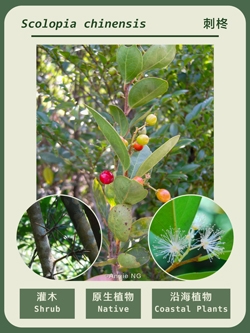 |
Scolopia chinensis (Chinese Scolopia) is a common tree species in the coastal environment. Their trunk and branchlets usually have stout spines. |
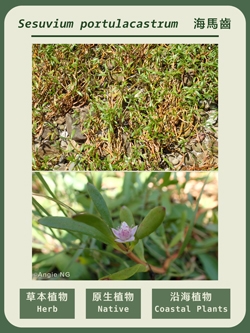 |
Sesuvium portulacastrum (Seaside Purslane) is a plant that helps sand-binding and embankment. Their leaves grow like ‘the teeth of the horse’, thus, giving them the Chinese name ‘Teeth of Sea Horses’ (海馬齒). |
|
Suaeda australis |
Suaeda australis (South Sea-blite) is usually clustered in sandy beaches and the edge of mangroves. Their flowers are fleshy, with the purple-green perianth. |
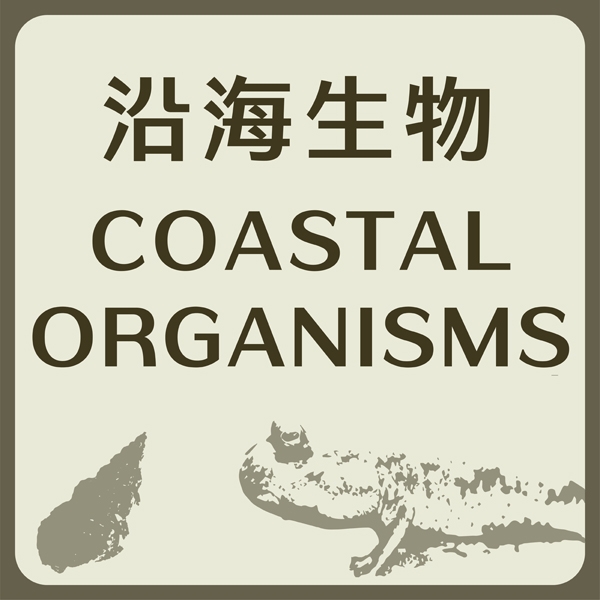
| Scientific name |
Description |
|
Cerithidea moerchii
|
Cerithidea moerchii is under the very diverse superfamily of Cerithioidea, which species distributed over the world. Cerithidea moerchii is common in mangroves, their protoconches (apex) are usually eroded. Their shells are yellow-white with purple-brown spiral band. |
|
Littoraria ardouiniana
|
Littoraria ardouiniana is mainly distributed in the mangroves of China and Taiwan. Their shells are thin and elongated. One distinctive characteristic of mature individuals is their outward-flipped outer lip. |
|
Littoraria melanostoma
|
Littoraria melanostoma inhabits in the intertidal area. Their shells are light yellow color, and columella with dark brown coloured patches. |
|
Reticunassa festiva
|
The shell of Reticunassa festiva is smooth and shiny, with obvious spiral ribs. |
|
Gelonia erosa
|
Gelonia erosa distributes in all mangrove mudflats of Hong Kong. Their thick shells are brown-yellow. |
|
Saccostrea cuccullata
|
The common name of Saccostrea cuccullata is Rock Oyster. Their shells are white in colour, with irregular shape. They often anchored tightly to coastal rocks. |
|
Parasesarma bidens
|
Carapace is square-shaped with light green color. It has red claws and dark green walking legs. They feed mainly on decayed mangrove leaves, seeds and branches. |
|
Periophthalmus modestus
|
Shuttles Hoppfish (Periophthalmus modestus) has strong pectoral fins and fishtail for jumping on mudflats. Besides, their gills could store water for respiration, and their moist skin could absorb oxygen from air. That's the reason why we often see them rolling on the mudflat to keep their skin moist. |

|
Species name |
Description |
|
Acridotheres cristatellus |
Crested Myna is a black bird with flashing white wing patches. There is a small, bristly crest just above the base of the bill. They are common in man-made sites, such as urban parks. |
|
Alcedo atthis 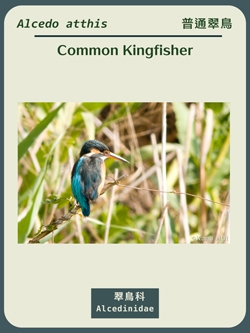 |
Common Kingfisher is a beautiful little bird with a long pointed bill. The bright blue and orange-red plumage are their signature . |
|
Amaurornis phoenicurus
|
As described, White-breasted Waterhen adults are dark slaty above and white below. Another distinctive feature is their tails with rusty patches. Their toes are extraordinarily long, which helps them spread their body weight evenly on those leaf-floating plants. Besides, their long and straight bills help them to look for small insects and molluscs in the water. |
|
Ardea alba
|
The dagger-like yellow bill helps them attack and hold the target fish. Besides, their long black legs help them slowly stalk prey, often fish, in shallow wetland, and wait for the best moment to attack them. |
|
Ardea cinerea
|
Grey Heron is always found in a group in a wetland. Their plumage consists of three colours - white, grey and black. The most identifiable features are their black eyebrows and black shoulders. |
|
Ardeola bacchus
|
Chinese Pond Herons have different colours at different growth stages. Immature or non-breeding adults are brown all over except the white wings; while mature adults are maroon on the cap, neck and chest and black-blue on the back. |
|
Copsychus saularis
|
Oriental Magpie-Robin is common in country parks and urban parks. Male Oriental Magpie-Robin is covered by black and white plumage; while the female Oriental Magpie-Robin is covered by grey-brown and white plumage. |
|
Egretta garzetta
|
Little Egret is active in all types of wetlands. They are small and snow-white, with a slender dark-brown bill, black and long legs as well as yellowish feet. |
|
Gracupica nigricollis
|
Black-collared Starling is the largest starling in Hong Kong. They are characterised by their blackish collar and yellow patches around the eyes. They always gather in groups and make noisy sounds. |
|
Halcyon smyrnensis
|
White-throated Kingfishers have brown bodies and metal-blue backs. While they prey, they like to stand on slender branches and look for good opportunities to catch fish, shrimp and crabs in the water. |
|
Nycticorax nycticorax
|
Adults have overall pale-greyish plumage with blackish cap and head. Their necks are usually tucked in, making them look like penguins. They prey on little fish and shrimp in wetland and water ponds. |
|
Orthotomus sutorius
|
Common Tailorbird is characterised by greenish back, brownish-red cap and a long bill. Its Chinese name (長尾縫葉鶯) describes its nesting style - stitching leaves. |
|
Pycnonotus jocosus
|
Red-whiskered Bulbul is a common bird in Hong Kong. They are characterised by their tall black crests and red patches on the ear. They are generally found in pairs or groups. |
|
Tachybaptus ruficollis
|
Little Grebe is a master diver, often hiding underwater. They are good at catching little organisms in water or hiding predators underwater. The webbed feet help them swim well in water and walk on soft soils without sinking. |
|
Zosterops simplex
|
Swinhoe's White-eye has prominent white eye-rings. They mainly feed on fruits, insects and nectars. |


